The fertilizing needs of fig trees vary depending on the climate, soil, fig variety, tree age, and more. However, with a closer look (and the help of this article!), you can learn more about what your fig trees need, and when.
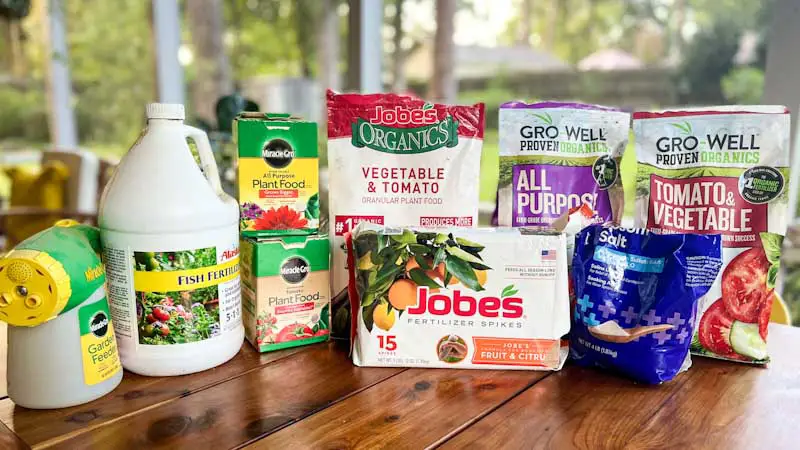
We may receive commissions from purchases made through links in this post, at no additional cost to you.
Like many gardeners, I have a shelf in my garage lined with bag after bag of fertilizer. My sandy soil means that if I want my plants to grow happily, I need to keep them fed (not unlike my children).
But when my kids are hungry, you can bet they will loudly let me know they’re hungry with the ubiquitous “Mommmm, can I have a snack?” If only my fig trees would let me know as clearly how often they need food. With all the information available and hundreds of kinds of fertilizers, how do I know for sure when and how to fertilize my fig trees?
Generally, in-ground fig trees should be fertilized up to 3 times per season (in early spring, at fruit formation, and when fruits ripen). Established trees may need only one feeding, if any, but those in sandy soil may need more. Potted fig trees should be fertilized every 1-3 weeks.
When you look into the topic of fertilizing fig trees, there seems to be conflicting information even among experts. And on top of it, fig trees growing in containers have somewhat different needs than those planted in the ground. Read on to learn the nuances of when to feed your fig trees, when not to fertilize, and what to use.
Times of Year to Fertilize In-Ground Fig Trees
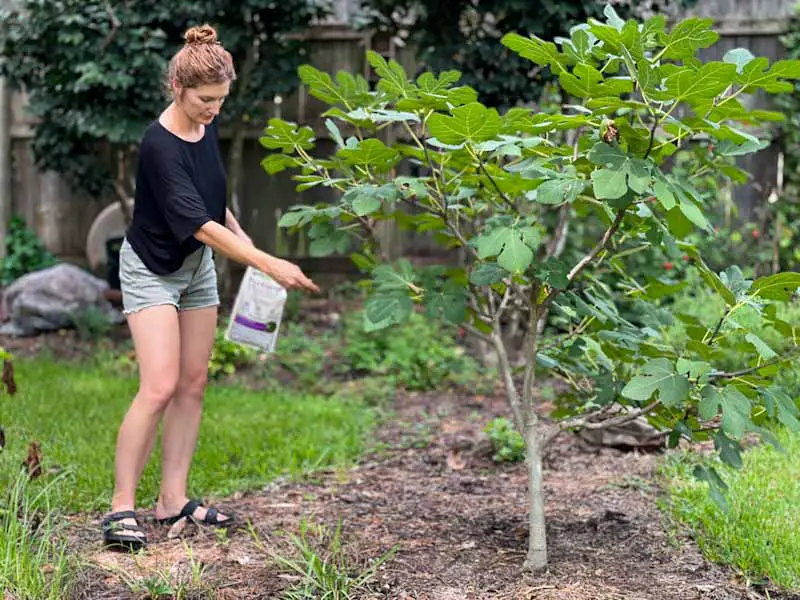
As a general rule, fig trees planted in the ground should be fertilized 3 times during the growing season: early spring, late spring/early summer (midseason), and mid/late summer. The first feeding helps give the tree an early boost of growth, and it should occur when the tree breaks dormancy and you see the first signs of green on the plant.
The midseason feeding should happen around 60 days later when the first few “figlets” (those tiny baby figs) start to form (it takes a lot of energy to reproduce!). When the full-grown figs begin to ripen, you should apply the third feeding. When exactly these three times fall can vary significantly based on your growing zone. The chart below can serve as a guideline for when these feedings should happen in your area.
| In-Ground Fig Fertilization: | Zone 5 | Zone 6 | Zone 7 | Zone 8 | Zone 9 | Zone 10 |
| 1st Feed (first growth) | mid Apr. | early Apr. | late Mar. | mid Mar. | mid Feb. | early Feb. |
| 2nd Feed (figlets forming) | mid Jun. | early Jun. | late May | mid May | mid Apr. | early Apr. |
| 3rd Feed (figs ripening) | mid Aug. | early Aug. | late Jul. | mid Jul. | mid Jun. | early Jun. |
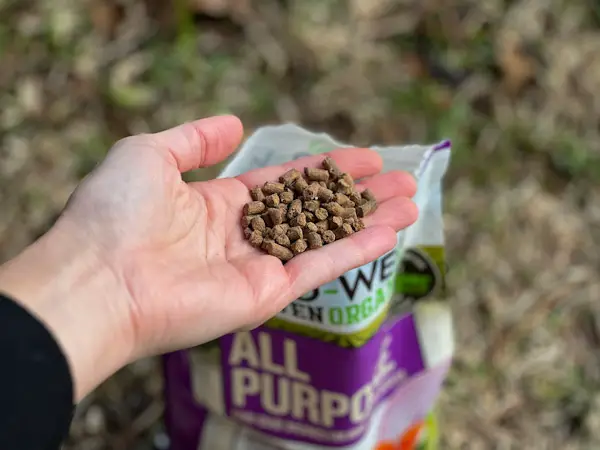
Three times a year is a good rule of thumb for figs, but a lot of factors can affect your ideal fertilization schedule. For example, if your tree is young and less established, the 3x-per-year schedule will be helpful to promote healthy growth both above and below the ground. A young tree may need fertilizing up to once a month, depending on what fertilizer you choose and what kind of soil you have (more on this later).
For older, more established trees, you only need to fertilize once when the new growth begins in early spring, if at all. Some growers recommend another feeding later in the summer when the figs are beginning to ripen. As a rule, less is more! When in doubt, feed your fig trees less than you think they may need. You can always add a feeding or two next season if your tree needs it.
Check out the video below to see exactly why and how I fertilize my in-ground and potted fig trees.
How to Know When Your Fig Tree Needs Fertizer
All fruit trees have the same basic needs: light, air, water, and food. Hopefully, you have provided the first two by planting your tree in the right location (check out the article below for more info). Light, air, and water all come from nature (well, watering may need occasional help from you), but food depends greatly on you (and your soil).
Learn more: Where to Plant a Fig Tree: Location Matters
In the fig’s natural environment, nutrition would be provided by the decomposing plants and animals that naturally occur in a thriving ecosystem. But for many of us, our backyards don’t provide the perfect environment for each plant to thrive. That’s where fertilizing comes in.

Test the Soil
One of the most important ways to figure out when your in-ground fig tree needs fertilizer is to do a soil test. Soil composition varies greatly depending on your location, so the only way to truly know what nutrients your soil lacks is with a soil test kit.
If you live in an area with sandy, very fast-draining soil, you may be lacking in nutrients for your fig tree. Sandy soil has trouble holding on to nutrients; mix in some compost and/or manure to improve drainage. You also may need to fertilize more often throughout the season (about once a month). Once you’ve discovered what your soil needs – if anything – you can more reliably determine when you need to fertilize.
Related: Soil Drainage for Fruit Trees: Everything You Need to Know
Location
The location of the fig tree will affect how often it needs additional food. If your fig tree is planted close to heavy-feeding plants (other trees or shrubs), that means it is competing for the nutrients in the soil and will probably need supplemental food.
A fig tree’s roots are widespread (about double the width of the tree’s canopy) and relatively shallow. If you’ve given your fig tree adequate space (at least 10 feet), it will more easily absorb what it needs from the soil.
Growth
A simple way to know when to fertilize is by observing the fig tree. Is it growing too slowly? Healthy fig trees grow about 12-18 inches per year. You can see how vigorously the tree is growing by observing the length of new shoots. According to the Alabama Cooperative Extension System, if your shoots are less than 18 inches long, your plant may not be growing optimally.
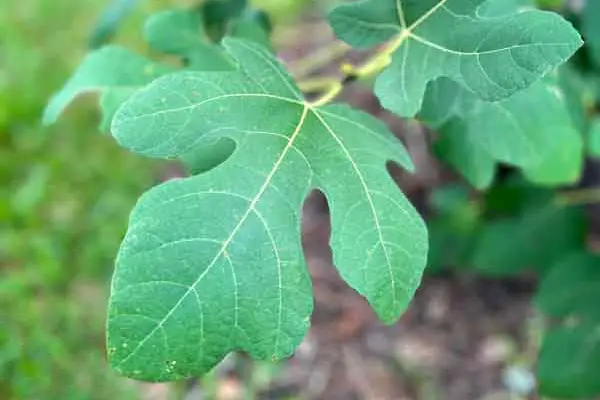
Leaves
You can also observe the leaves. Do the fig tree’s leaves seem lighter in color than they should be? Light green or yellowing leaves can indicate a lack of nutrition in a plant. Similar to humans, if your plant seems pale then it’s probably time for some food.
Fruit Production
Another indication your tree needs feeding is its fruit production. Did your tree produce too few figs last season? Or perhaps none at all? Did the fruit fall off the tree prematurely? Did the figs not ripen in time before the first frost? The answers to these questions can help you determine when (and how) to fertilize your fig tree.
For even more answers, see 11 Reasons Your Fig Tree Isn’t Fruiting (and What to Do).
When NOT to Fertilize Fig Trees
Already Growing Well
If your fig tree is established, growing well, and producing a good harvest of high-quality fruit…then congratulations! Leave well enough alone. You probably don’t need to fertilize your fig tree at all. It’s getting the nutrients it needs from the soil.
Figs are relatively light feeders; grown in the right conditions, they will need little to no additional nutrition. At most, you can dig in a little all-purpose organic slow-release fertilizer in the early spring to help your plant get going.
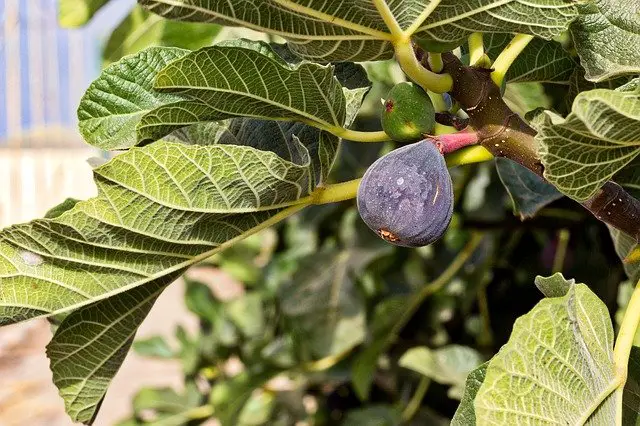
Overly Vigorous Growth
On the other hand, your tree may be growing a little TOO well. Is it bushy, leafy, and green, but producing little to no fruit? This may mean that your fig has absorbed too much nitrogen, which promotes leafy growth. An excess of nitrogen could also cause splitting and cracking in the branches, leaving the tree more susceptible to disease and cold damage.
Your fig tree could even be absorbing nitrogen from the nearby fertilized lawn…remember those wide-reaching roots? Next season, fertilize your tree less often and see how that affects fruit production.
Too Late in the Season
It is important not to fertilize your fig trees too late in the growing season. Fig trees need a period of dormancy (slow or no growth) to thrive. Fertilizing late in the season after the fruit has ripened signals the plant to keep growing, rather than winding down for the year.

Curious about any garden-related terms? Click on a highlighted word in the text, or visit The Fruit Grove Glossary to find out more.
Too Early in the Season
If you plant a new fig tree when it’s dormant (before any signs of green growth), don’t fertilize it yet. Feeding a fig tree too soon signals the plant to start growing at the wrong time. New growth is very sensitive to frost.
The nitrogen in the fertilizer will cause a quick flush of growth, and a frost can kill new buds and set the plant back for the year. Hold off on fertilizing your fig tree until you are positive there will be no more frosts.
Learn more: Fertilizing Fig Trees: 8 Times it’s NOT Necessary
What Kind of Fertilizer to Use When
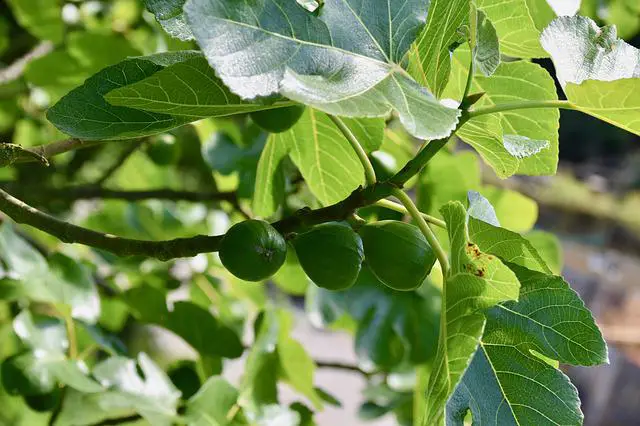
Fig trees have different nutrient needs at different times of year. At the beginning of the growing season, they need to put on leafy growth and shoots. In the midseason, a fig tree needs to put its energy toward setting fruit. And at the end of the summer it needs the energy to ripen the fruit before the first frost. Finally, instead of growing or ripening, the fig tree needs to prepare itself for dormancy over the winter. Hormones in the tree signal these growing phases, and different nutrients support each part of the cycle.
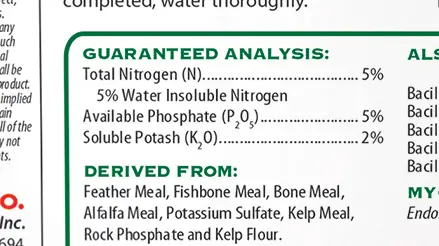
Decoding NPK Numbers: The three numbers on a fertilizer bag are known as the NPK ratio, and they stand for the percentage of nitrogen (N), phosphorus (P), and potassium (K) that the fertilizer provides. The higher the numbers, the more concentrated the nutrients are. So a fertilizer labeled 15-30-15 would have a higher concentration of nutrients than a 3-6-3, although the ratio of the three nutrients is the same.
For trees grown in the ground, stick with a slow-release, granular (preferably organic) fertilizer. These slow-release fertilizers are broken down by the microorganisms in the soil, making the nutrients available to the plant more gradually.
You will get a good result by sticking with an all-purpose, fairly even-ratio NPK fertilizer (such as 8-8-8 or 10-10-10). But for optimal health and fruit production, some growers suggest changing your fertilizer strategy depending on the part of the season and/or the specific situation and needs of your fig tree.
Have you heard that coffee grounds may be a good fertilizer for fig trees? Read Coffee Grounds and Fig Trees: Helpful or Harmful? to find out why (or why not…).
The Best Fertilizers to Use Throughout the Growing Season
You can use a balanced all-purpose fertilizer at any time. One of my favorites is Jobe’s Organic All Purpose 4-4-4, because its lower concentration is gentle on plants both in the ground and in pots. I prefer organic slow-release fertilizers because they are broken down slowly over time, and they contain ingredients with multiple benefits. But it may be beneficial to change up your fertilizer at different parts of the growing season, corresponding to the fig tree’s fruiting cycle.
Early Spring:
Right when you see little green buds poking out of the stems, a fig tree will benefit from a higher nitrogen percentage (the first number on a fertilizer bag). More nitrogen will encourage stems and leaves to grow, and the more stems, the more potential for figs.
I most frequently use Dr. Earth Natural Wonder Organic Fruit Tree Fertilizer 5-5-2 on my in-ground fig trees. Another good organic option is the Fox Farm Happy Frog All-Purpose Fertilizer 6-4-5. I haven’t tried it yet, but I’ve used other Fox Farm Products and have been extremely happy with the quality.
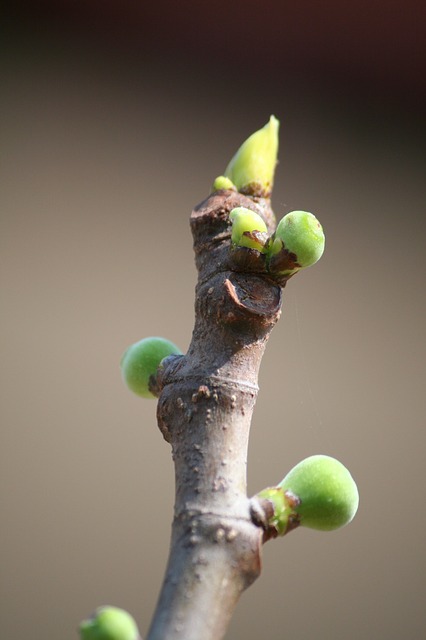
Midseason:
At this point, roughly 60 days after breaking dormancy, your fig tree starts to form little figlets. At this stage, it’s best to back off of the nitrogen so the plant’s energy can be diverted away from making new leaves and stems. Support the fruiting phase by choosing a fertilizer with a higher concentration of phosphorus.
I recommend a tomato and vegetable fertilizers, as they tend to have a higher middle NPK number to encourage blooming and fruiting. Dr. Earth Tomato, Vegetable, and Herb Fertilizer 4-6-3 is a great option.
End of Summer:
At this point, baby figlets will have grown into full-sized figs. The plant’s energy now needs to turn to ripening those figs before the first frost comes. The balanced NPK fertilizer in a lower concentration is the best choice for this part of the season such as Dr. Earth Premium Gold 4-4-4 Organic All Purpose Fertilizer, or the Jobe’s Organics recommended above.
Fertilizer Timing by Situation
If you live in an area with very sandy soil (like me), you will probably need to fertilize more often. Well-draining, sandy soil often has nutrient deficiencies because rain flushes away nutrients from the soil. Fertilize with a slow-release fertilizer at least 3 times per season, up to about once a month. You can use either a balanced NPK formula or one appropriate to the season, as explained above.
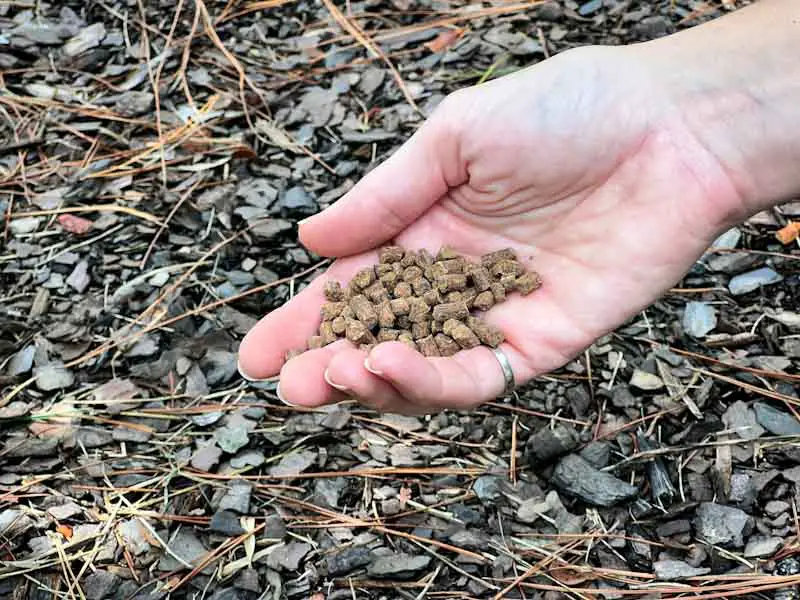
Younger trees also could need feeding more often – up to once a month. Prioritize a balanced fertilizer or one with more nitrogen. Be careful not to provide too much nitrogen, however, which can cause overly vigorous growth and can weaken the plant. Again, less is more with fig trees.
If you live in a colder climate and your figs have trouble ripening before the cold sets in, you could adjust your fertilizing schedule to help the fruit set early. Figs are native to Mediterranean climates, which means they love the heat and need certain temperatures to ripen. Do your first feeding of the year a little early, right when buds start to break, to encourage the onset of growth. Just make sure there is no risk of a late frost.
In general, there is no reason to use water-soluble fertilizers for in-ground fig trees. But if a tree is small and not well established, then it may be a good idea to use a soluble fertilizer at the beginning of the season or moving into the fruiting phase. But if your tree is well-established, a slow-release (preferably organic) fertilizer is all you need.
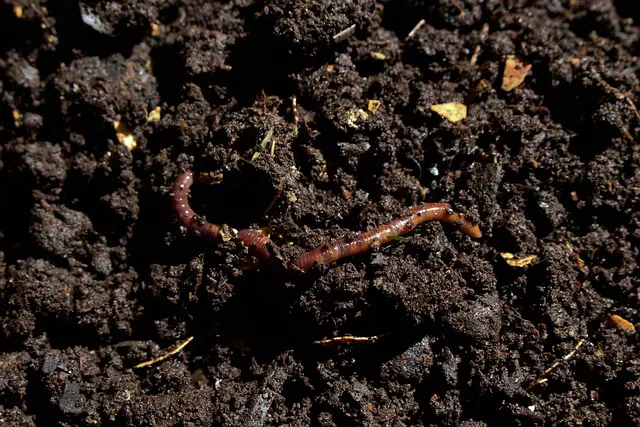
Fig trees in all situations respond well to applications of compost and/or well-rotted manure. Dig in some good-quality compost at the time of planting, but fig trees will also benefit from mulching with fresh compost a few times a year. Sprinkle a layer of compost or manure around the base of the tree (leaving a little space around the trunk) and lightly rake it into the top few inches of soil. The soil microbiome will thank you, and so will your fig trees.
When to Fertilize Potted Fig Trees
The basic food needs for fig trees growing in containers are the same as for those in the ground. However, the growing environment is very different, and this means a different fertilization approach. In-ground fig trees have room for their roots to spread out, searching out and absorbing nutrients over a wide area.
Related: How to Grow Figs in Containers: A Complete Guide
The roots of potted fig trees are restricted by the size of the container. In addition, the soil in a potted tree does not have the diverse microbiome present in the ground outside, which limits the amount of nutrients absorbed by the plant. So what does this mean for fertilizer?
Potted fig trees need to be fertilized frequently (every 10-14 days) for optimum plant health and fruit production. For best results use a water-soluble fertilizer, which will make the nutrients available to the plant more rapidly.
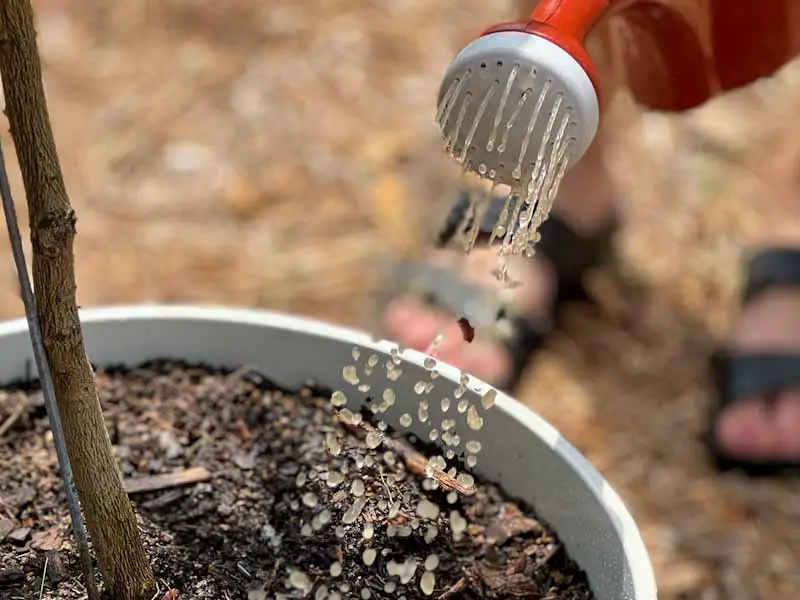
Frequent watering, as is usually necessary for a potted fig tree, flushes the nutrients out of the soil. Organic, slow-release fertilizers contain beneficial organic material in addition to the NPK listed on the bag. However, the less fertile soil in the pot won’t be able to break it down quickly enough for the tree to absorb what it needs.
If you want the most fruit possible for your potted fig, it may be challenging to use only organic fertilizers. Chemical fertilizers are derived from natural ingredients that are broken down into their chemical components, which allows them to be absorbed faster by the plants.
Non-organic chemical fertilizers, such as Miracle-Gro, tend to have a stronger concentration of nutrients. When used correctly (follow the manufacturers recommendations) this is very helpful to your potted fig tree, as it needs a lot of nutrition to stay healthy and produce delicious fruit. An organic soluble fertilizer, such as fish emulsion, is also recommended (although it’s not enough on its own).
Every 7-21 days (depending on how frequently you’ve been watering), add a soluble fertilizer such as Miracle-Gro Bloom Booster according to the instructions on the package. This particular fertilizer is great for potted fruiting fig trees, as it has a higher concentration of phosphorus (15-30-15).
Also add a solution of fish fertilizer (again, follow instructions), which is a fermented fish emulsion and acts as an overall multivitamin for your plants. This combination will keep your potted fig trees growing and fruiting happily.

